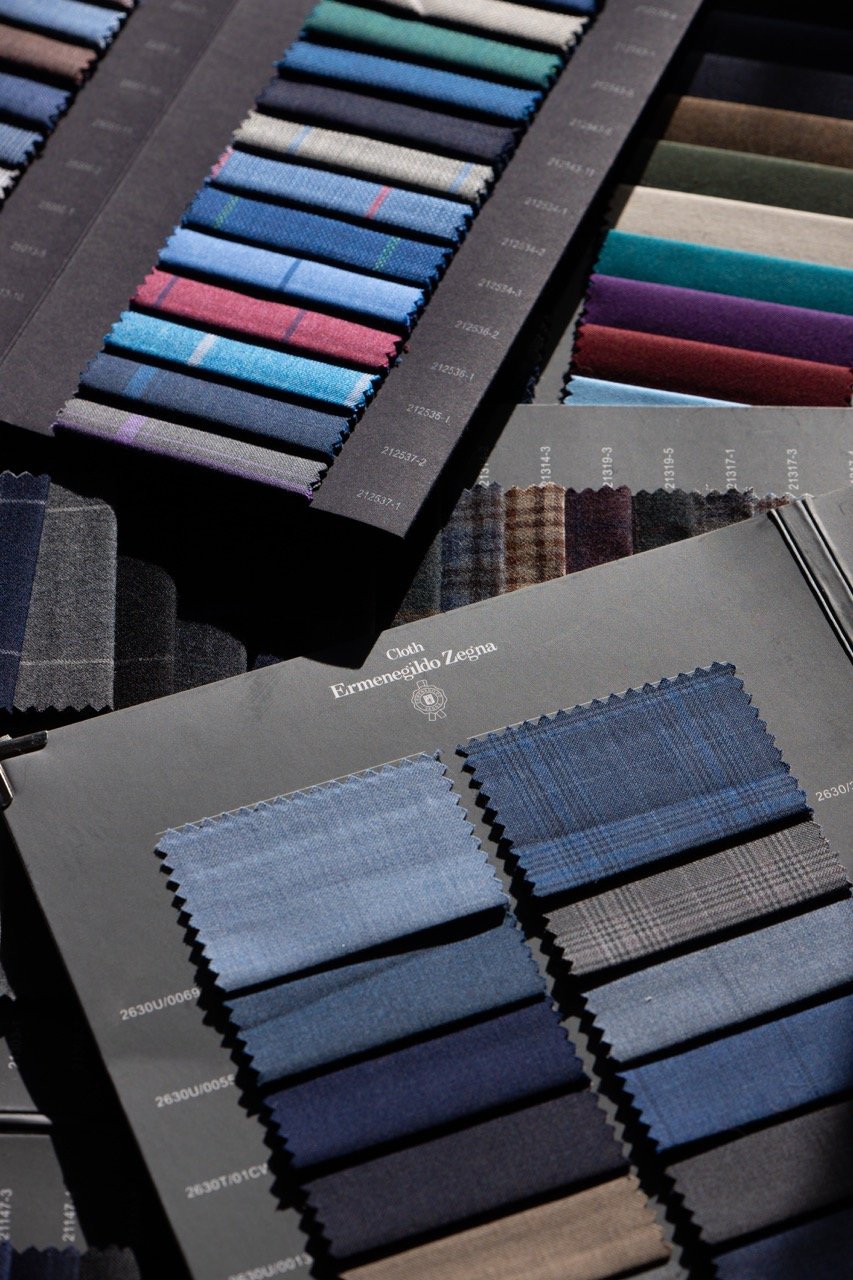The Makings of a Suit
Embarking on the journey to curate a wardrobe that includes hand-crafted custom suits is both exciting and rewarding. Understanding the intricate makings of a suit involves exploring a range of elements that contribute to its overall quality and appeal. From the fabric choice, which influences the suit’s feel and functionality, to the precision of tailoring that ensures a perfect fit, each component plays a crucial role. This style guide will walk you through the fascinating process of suit construction, offering insights into how each element comes together to create a garment that is not only stylish but also tailored to your personal lifestyle and preferences.
Canvasing: The Suit’s Foundation
Canvasing in a suit jacket or sport coat is like the secret ingredient that gives your garment its shape and structure. It's a layer placed between the outer fabric and the lining, helping the jacket mold to your body and allows the fabric to drape in a flattering way. “Drape” is a common clothing term that refers to the way the fabric falls and moves on your body—canvasing plays a big role in that. A full canvas jacket, for instance, might be your choice if you’re going for a timeless fit that adapts nicely over time, best for more formal occasions. On the other hand, if you're seeking something more casual or lightweight, like a summer blazer, you might opt for a half canvas or no canvas, which offers a relaxed drape and more casual look overall. Essentially, the presence or absence of canvas affects how structured or relaxed your jacket looks and feels, so choosing the right amount depends on the occasion and your personal style preference.
Full Canvas
This option involves a canvas layer running throughout the entire jacket, providing sturdiness and helping maintain a sharp silhouette. This means your jacket not only looks structured and intentional in shape but also holds that shape over time, adapting to your body's unique contours as you wear it. Full canvas construction is especially recommended for double-breasted suit jackets, where maintaining a crisp, structured look is key to pulling off that classic, powerful style.
Half Canvas
A half canvas in a suit or sport coat is like having the best of both worlds when it comes to structure and comfort. This construction method involves a canvas layer that covers only the upper part of the jacket (optionally including the lapel in the case of a custom suit), allowing for a structured fit across the shoulders and chest while remaining flexible and comfortable below the buttoning point. It's a great option if you’re looking for a jacket that’s not too rigid but still offers a refined look. Many people choose half canvas for its balance of quality and affordability, making it a popular choice for those who want a well-fitted jacket without breaking the bank.
No Canvas
Having no canvas in a suit or sport coat is like the minimalist route for your wardrobe. Instead of a canvas layer, the outer fabric is directly in contact with the lining, which results in a lightweight and breathable option. This construction is perfect if you're looking for something more casual or if your custom suit is made with the intention of being worn in hot weather and you don’t want your body heat trapped inside the jacket. However, it's good to know that while no canvas suits are lighter and more relaxed, they might not offer the same level of durability and shape retention as their canvased counterparts. This means they may not contour to your body as naturally over time. Despite this, no canvas suits are great for situations where you want a simple, everyday option without the commitment to a more structured piece.
How it’s Made: Fused or Stitched
The difference between a fused and stitched canvas in suits or sport coats can have a big impact on how your jacket feels and lasts. Having a fused canvas means the fabric and canvas are bonded together using adhesive. This method provides a decent level of adhesion and is used exclusively to keep costs down. Fused linings will not stand up as well over time, especially with frequent wear, as the adhesive can break down. On the other hand, a stitched canvas involves sewing the canvas to the outer fabric, which allows the jacket to move more naturally with you. This method is more durable and can extend the life of your jacket, making it a all but required if you’re looking for something that’ll go the distance.
Understanding these differences can help you make the right choice for your wardrobe needs. If you’re in a pinch and looking for something cheap, a fused canvas will last for the night and keep your costs down. If you’re looking for something that will last, make sure it has a stitched canvas!
Suit Silhouettes
As you delve deeper into the nuances of suit design, understanding the impact of jacket styles, such as single and double-breasted, is essential. This section will explore how these different jacket styles shape the overall silhouette of a suit, adding distinct elements that reflect personal style and occasion suitability.
Single-Breasted
Single-breasted jackets make up a majority of what you’ll find on the market and being worn by your peers. Known for their classic design, these jackets feature a single row of buttons and a neat, clean cut. Their versatility is one of their greatest strengths—whether you're dressing for a business meeting, a casual outing, or a formal event, a single-breasted jacket adapts seamlessly. This style is also flattering on various body types, providing a sleek silhouette that enhances your natural shape.
Double-Breasted
Double-breasted jackets are characterized by their overlapping front flaps and two parallel rows of buttons. Traditionally associated with formal attire, these jackets are often seen in settings that call for a more polished appearance, such as business meetings or formal events. Despite their formal roots, double-breasted jackets have been used more and more often lately in more casual looks. Wearing one open and without a tie is a sort of modern countercultural movement, rejecting the traditionally buttoned up and proper usage of the double-breasted suit.
Tuxedos
Tuxedos are distinct from regular suits through key features such as satin lapels, satin-covered buttons, and a satin stripe along the trousers. Traditionally reserved for black-tie events, tuxedos embody formal styling that sets them apart in terms of elegance and details. Unlike regular suits, which can be styled for both work and social events, tuxedos are specifically designed for formal occasions, such as weddings, galas, and award ceremonies, where a more polished and refined appearance is required. The classic components of a tuxedo, including a white tuxedo shirt, black bow tie, and patent leather shoes, maintain its status as the go-to choice for events that demand a high level of formality and style.
Fabric: The “Wow” Factor
Fabric plays a huge role in how your suit looks and feels. Natural fabrics like wool, cotton, and linen each bring their unique characteristics to a suit. Wool is a popular choice due to its versatility, offering a range of weights suitable for different climates and seasons. Its natural elasticity and ability to retain shape make it a preferred option for those seeking a suit that adapts well to various temperatures and maintains a polished look throughout the day. Cotton, on the other hand, provides a lighter and more breathable alternative, ideal for warmer climates or less formal settings. It offers a crisp, clean appearance, though it may wrinkle more easily than wool. Linen is celebrated for its exceptional breathability and relaxed aesthetic, making it a favorite for summer suits or casual occasions. However, linen's tendency to wrinkle can lend a charming, laid-back look that some find appealing. Common fabric blends, such as wool-silk or cotton-linen, combine the strengths of each material to enhance the suit's performance and feel. Wool-silk blends, for example, add a touch of luxury and sheen to the fabric, perfect for those who want a sophisticated yet subtle flair. Cotton-linen blends offer the breathable quality of linen with the added structure of cotton, maintaining comfort and style.
Choosing the right fabric also depends on personal factors such as lifestyle, work environment, and budget. For someone in a corporate setting, a classic wool suit might provide the balance of professionalism and comfort needed for daily wear. Meanwhile, a cotton or linen suit could suit a more creative or casual workspace. Budget considerations are also crucial, as natural fibers can vary in price. Ultimately, fabric choice is an expression of personal style and practicality, allowing the wearer to curate a wardrobe that suits their unique needs and preferences.
If you want to go down the rabbit hole of learning how to choose the right fabric for your custom suit, click here.
The Tailor’s Role: Bringing It All Together
When it comes to achieving the perfect fit and style in a suit, the expertise of a skilled tailor or custom clothier is invaluable. Enhancing an off-the-rack suit through precise tailoring can transform its appearance, ensuring it complements the wearer's body shape and personal style. This process involves adjustments to the suit's measurements, enhancing its fit and elevating its overall look.
For those seeking a more personalized approach, working with a custom clothier like Capitol Hill Clothiers to build a suit from scratch offers unparalleled benefits. This collaboration allows for the creation of a garment tailored to the individual's design and fit specifications, resulting in a suit that not only meets but exceeds expectations in terms of comfort and aesthetic appeal.
Choosing a custom suit is about more than just clothing; it’s about embracing your personal style. The process might seem detailed, but it’s worth it for the confidence and satisfaction a well-fitted suit provides. Whether it’s for work or a special occasion, a custom suit is a fantastic addition to any wardrobe, offering both style and comfort tailored just for you.
So go ahead, step into the world of custom tailoring, and discover the joy of wearing something made just for you.





